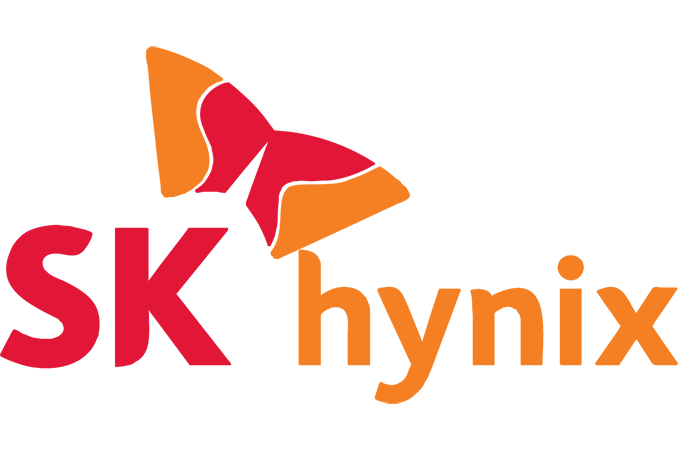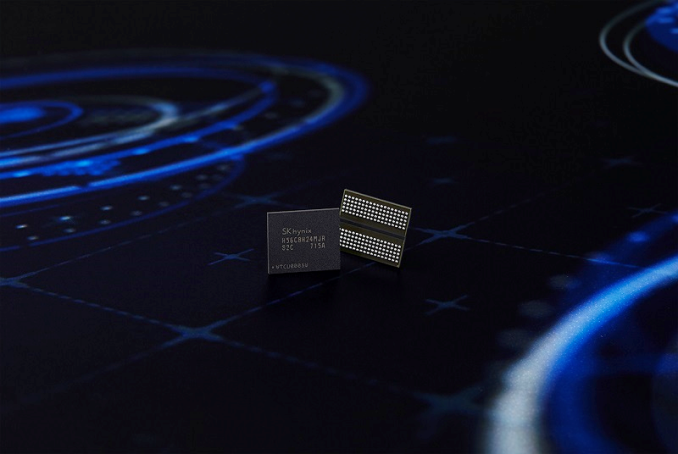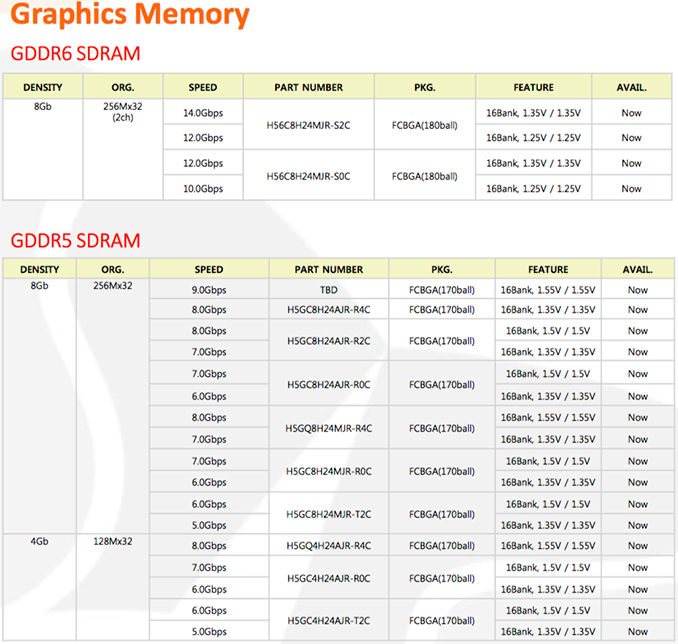SK Hynix Lists GDDR6 Memory as ‘Available Now’, Publishes Final Specs
by Anton Shilov on February 6, 2018 8:00 AM EST
SK Hynix has updated its product catalogue and now lists its GDDR6 memory chips as “available now”. In addition, the company published final specifications of its GDDR6 product family, confirming 10, 12 and 14 Gbps transfer rates with 1.25 V as well as 1.35 V voltages.
SK Hynix was the first DRAM maker to announce mass production of GDDR6 memory last April. Then, the company added two GDDR6 DRAM devices into its catalogue in May, disclosing their general specifications. The company promised to start GDDR6 shipments by the end of 2017, but did not make any formal announcements on the matter late last year. SK Hynix will likely make certain GDDR6-related comments in the coming weeks, but recently it published its Q1 2018 databook where GDDR6 chips are listed as “available now.”
SK Hynix’s GDDR6 product portfolio includes four memory configurations, all offering 8 Gb capacities with either 10 Gbps, 12 Gbps, or14 Gbps data transfer rates. The chips feature a 256Mx32 organization and operate as two 16-bit interfaces to increase effective utilization of the bus (a speculation at this point) — a standard feature of the GDDR6 spec. It is noteworthy than in addition to GDDR6 chips with 1.35 V Vdd/Vddq, SK Hynix also lists chips that offer a below-specification 1.25 V operating voltage, presumably as a low-power option – and one that should offer lower power than even GDDR5. Based on the part numbers, the 1.35 V and 1.25 V parts are the same chips, but there may be differences when it comes to end-products. 1.25 V GDDR6 chips will be particularly useful for various low-power, Mini-ITX and mobile graphics and other memory bandwidth-hungry applications. Meanwhile, like other GDDR6 chips, SK Hynix’s ICs come in 180-ball FCBGA packages.
| Specifications of SK Hynix's 8 Gb GDDR6 Memory Chips | |||||||
| Part Number | Packaging | Data Rate | Bandwidth per Chip |
Voltage | Organization | ||
| H56C8H24MJR-S2C | GDDR6 180-ball |
14 Gbps | 56 GB/s | 1.35 V | 256Mx32 | ||
| 12 Gbps | 48 GB/s | 1.25 V | |||||
| H56C8H24MJR-S0C | 12 Gbps | 48 GB/s | 1.35 V | ||||
| 10 Gbps | 40 GB/s | 1.25 V | |||||
Meanwhile it's worth nothing that back in January, Samsung said that it had started mass production of 16 Gb GDDR6 devices featuring a 18 Gbps I/O speed. So it's interesting to note that just looking at each vendor's published specifications, SK Hynix’s would appear to be trailing in both density and transfer rates. With that said, however, Samsung has been known to announce memory well in advance – and indeed they were calling their 16Gb chip "early production" – so it's not clear whether Samsung's high density chips are actually available to manufacturers. So SK Hynix may not be as far back from Samsung as it first appears, if they're behind at all.
With at least two major makers of DRAM ready to ship their GDDR6 chips, it is logical to assume that graphics cards based on the new type of memory are just around the corner.
It is worth noting that SK Hynix’s Q1 2018 product catalogue no longer lists 10-Gbps GDDR5 memory chips that were added there back in May. In fact, even 9-Gbps GDDR5 ICs do not have a part number, which may indicate that high-performance GDDR5 products are not a priority for SK Hynix just now.
Related Reading:
- Samsung Starts Mass Production of 16Gb GDDR6 Memory ICs with 18 Gbps I/O Speed
- Micron Finishes GDDR6 Internal Qualification, Eyes H1'2018 Mass Production
- Samsung Starts Production of 8 Gb DDR4-3600 ICs Using 2nd Gen 10nm-Class Tech
- Samsung Pre-Announces 16 Gbps GDDR6 Chips for Next-Gen Graphics Cards
- Micron Discusses GDDR: 16 Gbps GDDR5X, 16 nm GDDR6 and GDDR5
- SK Hynix Advances Graphics DRAM: GDDR6 Added to Catalogue, GDDR5 Gets Faster
Source: SK Hynix












8 Comments
View All Comments
rsandru - Tuesday, February 6, 2018 - link
Well done SK Hynix.Now can you please get back to reality and produce more DDR4? Current prices are just insane.
Pork@III - Tuesday, February 6, 2018 - link
Reality is too poor. In fantasy world of speculations have more money.wrkingclass_hero - Tuesday, February 6, 2018 - link
SK Hynix just posted record profits. This "shortage" is pure market manipulation. Look at the profits for all of the memory fabs, and compare it to the "shortage" timeline. You'll see that they're all doing better than ever on what should be lean years. Unless federal/ legal regulations come down hard on them, or a new player comes into the market, I don't see things changing for the time being.MrSpadge - Wednesday, February 7, 2018 - link
To be fair, they need to pay for R&D of the next processes and the next multi-billion $ fabs from the current profits during "fat" years. And... price fixing in the DRAM industry is completely unheard of, isn't it? ;/peevee - Friday, February 9, 2018 - link
These are profits. After R&D was subtracted from sales with all the other costs.surt - Friday, February 9, 2018 - link
Shortage years are always the best for manufacturers. They get killed in glut years when the prices are too low.wumpus - Thursday, April 26, 2018 - link
It also isn't clear that any manipulation was needed, from what I've heard the "shortage" was from Samsung selling tons of memory (this might just be the GDDR5 "shortage") to the Chinese phone market. It isn't like they are burying RAM or something.Note that the original RAM "price fixing" charges only happened after years of business rags whining about "damaging price wars" (i.e. not price fixing). Price fixing is the norm, and competition (especially in something as dominated by 2-3 companies like DRAM) is obvious in the rare price war.